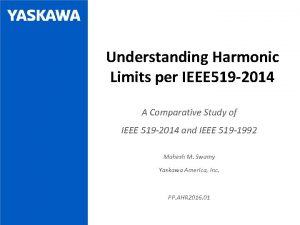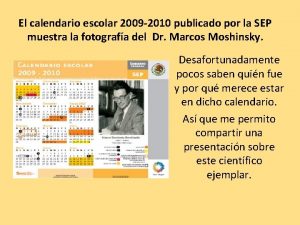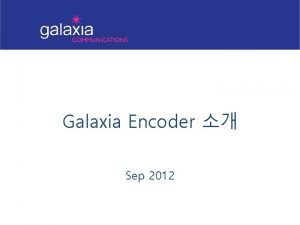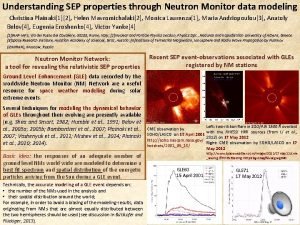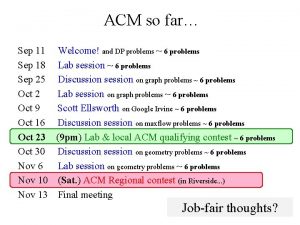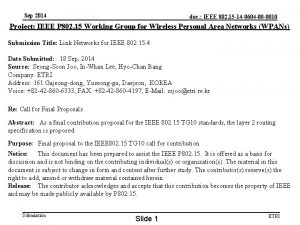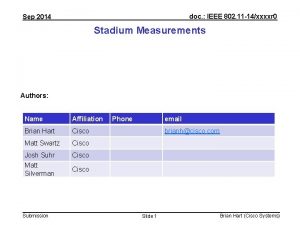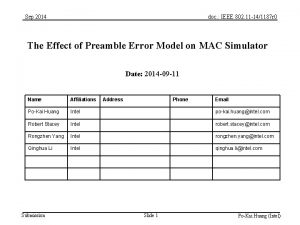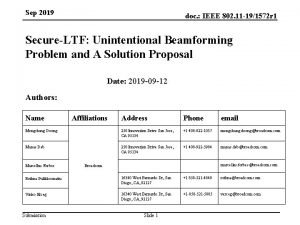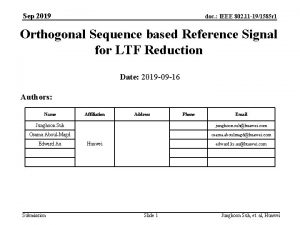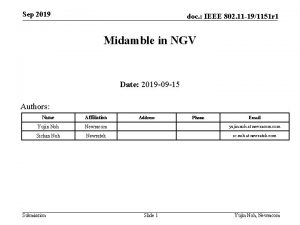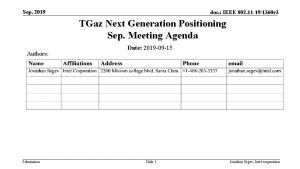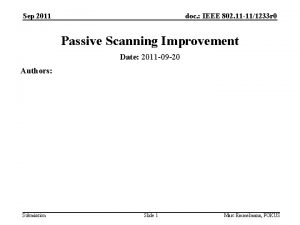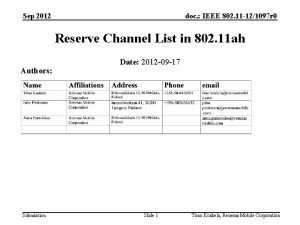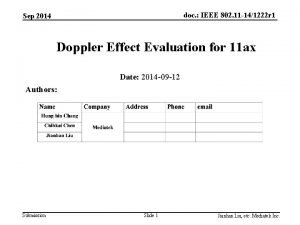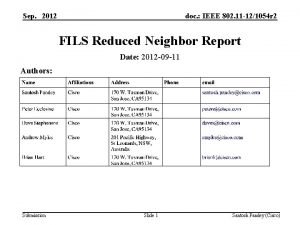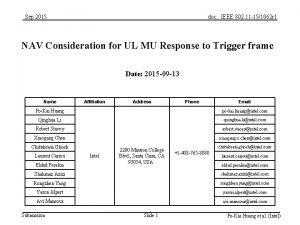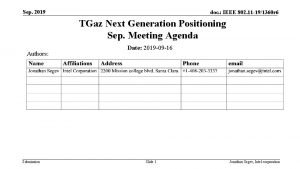Sep 2014 doc IEEE 802 11 141181 r

















![Sep 2014 doc. : IEEE 802. 11 -14/1181 r 0 References [1] 11 -10/1079 Sep 2014 doc. : IEEE 802. 11 -14/1181 r 0 References [1] 11 -10/1079](https://slidetodoc.com/presentation_image_h2/8ff593c02f929668a00353ff48f4f494/image-18.jpg)
- Slides: 18

Sep 2014 doc. : IEEE 802. 11 -14/1181 r 0 Measurements on A-MPDU performances under various channel conditions Date: 2014 -09 -15 Authors: Submission Slide 1 John Son, WILUS Institute

Sep 2014 doc. : IEEE 802. 11 -14/1181 r 0 Motivations for A-MPDU Experiments • SK Telecom is operating approx. 130, 000 Wi-Fi hotspots in Korea • Severe throughput degradation is observed in some hotspots installed at crowded sites, • even though AP-STA has a good channel condition (i. e. , high RSSI, Line-of. Sight) • On those hotspots, we could increase throughputs by reducing the max A-MPDU aggregation size below 64 • In this contribution, we evaluate performances of A-MPDU under various channel conditions. Also, several observations regarding interplay of several parameters and algorithms around A-MPDU aggregation are provided. Submission Slide 2 John Son, WILUS Institute

Sep 2014 doc. : IEEE 802. 11 -14/1181 r 0 A-MPDU Channel Contention PHY HDR DATA 1 DATA 2 BA ACK Block Ack SIFS Normal DATA/ACK exchange A-MPDU/BA exchange (Implicit BA policy) • A-MPDU increases MAC efficiency by sending multiple aggregated MPDUs when the channel is acquired • A-MPDU can aggregate up to 64 MPDUs • All MPDUs are addressed to the same receiver and modulated with the same MCS • MPDU delimiter is added to each MPDU with self-CRC protection • Receiver acknowledges each subframe with one Block Ack message Submission Slide 3 John Son, WILUS Institute

Sep 2014 doc. : IEEE 802. 11 -14/1181 r 0 A-MPDU’s Maximum Limits in 11 ac [1] MPDU delimiter 4 B FCS (A-)MSDU 0~3 B MPDU Max MPDU Length: (11, 454 B) - 3895, 7991, or 11, 454 - limited by FCS’s error detecting capability Pad MAC HDR 4 B PHY HDR MPDU Length MPDU subframe 1 MPDU subframe 2 … MPDU subframe N A-MPDU Length/Duration Max A-MPDU Length: (1, 048, 575 B) - 8191, 16383, 32767, 65535, 131071, 262143, 524287, or 1, 048, 575 • • Max A-MPDU Aggregation: (64) - limited by Block Ack’s window limit Max A-MPDU Duration: (5. 46 ms) - for protection of A-MPDU from legacy STAs - limited by L-SIG Rate/Length field In the following experiments, we found that reducing the Max A-MPDU Aggregation (N) below 64 could increase throughputs in some cases. With analysis on packet traces, we provide our observations on possible reasons for that. Submission Slide 4 John Son, WILUS Institute

Sep 2014 doc. : IEEE 802. 11 -14/1181 r 0 Experiment Settings • Place-1: RF Shield Room @SKT • Place-2: Seoul Railway Station • Access Point • • 802. 11 ac @5 GHz • 20/40/80 MHz • 20 d. Bm TX power STA (Galaxy S 4) • • 802. 11 ac @5 GHz Traffic • Chariot Server, TCP DL traffic only, 18 sec duration • Traffic Capture: Wireshark 10. 8. 2 • IEEE 802. 11 • RTS/CTS ON • 1 x 1 SISO • AP’s TX Max A-MPDU aggregation size was changed (no changes on STA side) Submission Parameters Shield Room Seoul Railway Station RSSI High (~40 d. Bm) Mid (~50 d. Bm) Low (~65 d. Bm) Population Density Zero High BW 20, 40, 80 20* Max A-MPDU Aggregation (N) 1, 8, 16, 32, 64 Low *could not experiment 40/80 MHz BW due to many 11 ac APs in Seoul station Slide 5 John Son, WILUS Institute

Sep 2014 doc. : IEEE 802. 11 -14/1181 r 0 Shield Room - High RSSI (20/40/80 MHz) trace analysis on the next slide • Experiments • • • Inside shield room, AP-STA are located close to each other (-35~-40 d. Bm RSSI on STA) Measured STA’s DL throughput by changing AP’s Max A-MPDU aggregation (N) under 20/40/80 BW Results • • Throughput was maximized when N is limited to 16 @20/40/80 MHz Analysis of throughput changes on N=16, 32 @80 MHz is provided in the next slide Submission Slide 6 John Son, WILUS Institute

Sep 2014 doc. : IEEE 802. 11 -14/1181 r 0 Shield Room – High RSSI (N=16, 32 @80 MHz) Ø Within A-MPDU, the latter MPDUs had higher RX failure ratio Ø Most A-MPDUs were transmitted with the max aggregation size (16, 32 was the limiting factor) Ø A-MPDUs occupied smaller airtime than the max duration Ø MCS Mean decreased with bigger max aggregation size (N) Ø MCS fluctuated with bigger max aggregation size (N) Submission Slide 7 John Son, WILUS Institute

Sep 2014 doc. : IEEE 802. 11 -14/1181 r 0 Shield Room – Low RSSI (20/40/80 MHz) trace analysis on the next slide • Experiments • • • Inside shield room, AP’s equipped with attenuator to lower TX power (-60~-65 d. Bm RSSI on STA) Measured STA’s DL throughput by changing AP’s Max A-MPDU aggregation (N) under 20/40/80 BW Results • • Throughput was maximized when N is limited to 16@20/80 MHz, and to 32@40 MHz Analysis of throughput changes on N=16, 64@80 MHz is provided in the next slide Submission Slide 8 John Son, WILUS Institute

Sep 2014 doc. : IEEE 802. 11 -14/1181 r 0 Shield Room – Low RSSI (N=16, 64@80 MHz) Ø Within A-MPDU, the latter MPDUs had higher RX failure ratio (more severe in Low RSSI) Ø (N=16) Most A-MPDUs Ø were transmitted with the max aggregation size (16 was the limiting factor) (N=64) Most A-MPDUs were transmitted with smaller sizes than the max aggregation size Ø (N=16) A-MPDUs Ø (N=64) Many A-MPDUs occupied smaller airtime occupied similar airtime than the max duration with the max duration (5. 46 ms was the limiting factor) Ø MCS Mean decreased with bigger max aggregation size (N) Ø MCS fluctuated with bigger max aggregation size (N) Submission Slide 9 John Son, WILUS Institute

Sep 2014 doc. : IEEE 802. 11 -14/1181 r 0 Observations for Throughput degradations • Observation 1 – Unequal MPDU subframe error rate Ø Within A-MPDU, the latter MPDUs had higher error rate • Preamble-based channel estimation may not perform well for the latter MPDUs • Observation 2 – MCS varies with aggregation size Ø MCS decreased with bigger max aggregation size (N) Ø MCS fluctuated with bigger max aggregation size (N) • From the Observation 1, more aggregated A-MPDUs will have higher chance of receiving Block Acks with partial bitmap • The partial bitmap (any “ 0” in bitmap) can trigger link adaptation algorithm on sender STA to lower MCS • Also, it can trigger exponential backoff at sender STA • Therefore, limiting the aggregation size may increase throughputs in some case Submission Slide 10 John Son, WILUS Institute

Sep 2014 doc. : IEEE 802. 11 -14/1181 r 0 Shield Room – Comparisons (N=64) High RSSI, 20 MHz High RSSI, 40 MHz Duration -limited Low RSSI, 40 MHz Low RSSI, 80 MHz Duration (5. 46 ms) -limited Duration Submission AMPDU (N=64) -limited (5. 46 ms) Low RSSI, 20 MHz High RSSI, 80 MHz Slide 11 John Son, WILUS Institute

Sep 2014 doc. : IEEE 802. 11 -14/1181 r 0 Observations for A-MPDU’s limiting factor • Observation 3 – Max 64 aggregation was the limiting factor at high rates Ø Under High RSSI and Wide BW, throughput was limited by the max 64 aggregations • Observation 4 – Max 5. 46 ms duration was the limiting factor at low rates Ø Under Low RSSI and Narrow BW, throughput was limited by the 5. 46 ms duration Submission Slide 12 John Son, WILUS Institute

Sep 2014 doc. : IEEE 802. 11 -14/1181 r 0 Railway Station – Population Density (P/D) AP AP Population density variation 5 m STA ` STA 1. 5 m 11 m • Low Population Density example Low Population Density • • AP Normal status between train arrivals High Population Density • • After a train arrives at the platform, we could obtain continuously high population density for 1~2 minutes From the height of the AP, it is noted that Lo. S path bet’n AP-STA was secured even with high population density. High Population Density example Submission Slide 13 John Son, WILUS Institute

Sep 2014 doc. : IEEE 802. 11 -14/1181 r 0 Railway Station – Low & High P/D (20 MHz) analysis on the slide 15 analysis on the slide 16 • Experiments • • • AP-STA are located 11 meters away with dynamic population density (-50~-55 d. Bm RSSI on STA) Measured STA’s DL throughput by changing AP’s Max A-MPDU aggregation size under 20 MHz BW Results • • Throughput maximized when N is limited to 8 @ Low & High P/D Analyses of throughput changes according to P/D and N are provided in the next slides Submission Slide 14 John Son, WILUS Institute

RSSI Sep 2014 doc. : IEEE 802. 11 -14/1181 r 0 Railway Station – Population density effect • Observation 5 – Population density effect Low P/D Ø High population density incurs more channel variations, which incur MCS fluctuations • Our result complements [2][3] that population density can still affect performances even without direct human body blockages. High P/D Submission Slide 15 John Son, WILUS Institute

Sep 2014 doc. : IEEE 802. 11 -14/1181 r 0 Railway Station – High P/D (N=8, 32 @20 MHz) Ø Within A-MPDU, the latter MPDUs had higher RX failure ratio (more severe in High P/D) Ø (N=8) Most A-MPDUs Ø were transmitted with the max aggregation size (8 was the limiting factor) (N=32) Most A-MPDUs were transmitted with smaller sizes than the max aggregation size Ø (N=8) A-MPDUs Ø (N=32) Many A-MPDUs occupied smaller airtime occupied airtime up to the than the max duration (5. 46 ms was the limiting factor) Ø MCS Mean decreased with bigger max aggregation size (N) Ø MCS fluctuated with bigger max aggregation size (N) Submission Slide 16 John Son, WILUS Institute

Sep 2014 doc. : IEEE 802. 11 -14/1181 r 0 Conclusions • In this contribution, we provided performance measurements of A -MPDU under various channel conditions, bandwidths, and population densities. • When many MPDUs are aggregated, we observed that frequent link adaption is triggered from the partial bitmap Block ACK which lowers throughputs. • Also, it is noted that “ 64 aggregation” and “ 5. 46 ms duration” could play as the limiting factor in high and low rate transmissions respectively. • Like 11 n and 11 ac, 11 ax should also enhance the frame aggregation feature considering both the current limitations and the new requirements. Submission Slide 17 John Son, WILUS Institute
![Sep 2014 doc IEEE 802 11 141181 r 0 References 1 11 101079 Sep 2014 doc. : IEEE 802. 11 -14/1181 r 0 References [1] 11 -10/1079](https://slidetodoc.com/presentation_image_h2/8ff593c02f929668a00353ff48f4f494/image-18.jpg)
Sep 2014 doc. : IEEE 802. 11 -14/1181 r 0 References [1] 11 -10/1079 r 1 Max Frame Sizes [2] 11 -14/0112 r 1 Wi-Fi interference measurements in Korea – Part II [3] 11 -14/0113 r 1 Modeling of additional channel loss in dense WLAN environments Submission Slide 18 John Son, WILUS Institute
 Bridges from 802.x to 802.y
Bridges from 802.x to 802.y Bridges from 802.x to 802.y
Bridges from 802.x to 802.y Ieee 802 3 compliance
Ieee 802 3 compliance Ieee802.22
Ieee802.22 Arquitetura ieee 802
Arquitetura ieee 802 El 802
El 802 Ieee 802 standard
Ieee 802 standard Bluetooth ieee 802
Bluetooth ieee 802 802 ieee
802 ieee Ieee 802
Ieee 802 Ieee 802 family
Ieee 802 family Ieee 519 harmonic limits
Ieee 519 harmonic limits Escuela segura sep
Escuela segura sep Calendario escolar 2009-2010
Calendario escolar 2009-2010 Sep i
Sep i Student exchange program ipsf
Student exchange program ipsf Sep properties
Sep properties Irm cervicale sep
Irm cervicale sep Nueva escuela mexicana.sep.gob.mx
Nueva escuela mexicana.sep.gob.mx











